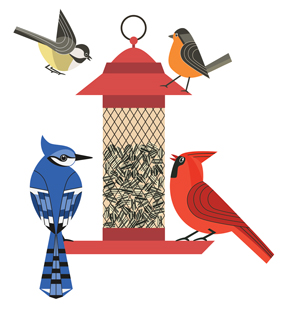
There are upwards of 11,000 species of birds worldwide—and each is a canary in the coal mine. Birds are a powerful reflection of the health of the environment, and with 3 billion birds lost in North America over the last half-century, avian advocates like Jamie Bussey are working on behalf of both our fine-feathered friends and Mother Nature. “At the Audubon Society, we like to say that what we do for birds we’re doing for the planet.”
Q. Bird populations have declined by 30 percent since 1970—why?
A. It comes down to climate change. The changes we’ve seen recently in precipitation levels and weather patterns, along with the increase in wildfires and the intensity of storms, have different implications for different birds. For example, Carolina wrens and northern cardinals are expanding their range northward due to warming temperatures and habitat changes. But if those areas don’t have adequate resources like food, that will affect the bird populations. Meanwhile, an unexpected storm [either in intensity or location] can destroy the nests of shorebirds like red knots and salt-marsh sparrows.
Q. What simple things can people do around their homes today to help birds thrive?
A. Advocacy starts in your own backyard. Put out clean and food and water; provide safe passage by dimming your lights during high migratory periods; and reduce window collisions by creating patterns on reflective glass surfaces, installing external screens, closing blinds or curtains, and moving indoor plants away from windows. Also add native plants to your garden; they’re great for both birds and pollinators.
Q. How did you get into birding?
A. During the pandemic, there was a house sparrow building a nest in our neighbor’s window. My husband and I were fascinated with the bird, which we named Barney. He brought a lot of peace and joy during a very stressful time and helped me make sense of my place in the world.
Barney [sparked] my curiosity, and, in typical fashion, I threw myself into taking classes through the Cornell Lab of Ornithology’s Bird Academy. Fast forward two years, and my girlfriends and I are taking a trip to Cape May, New Jersey, to go birding.
My favorite is the gray catbird because of its call. It does sound like a cat sometimes, but it has long and wide-ranging songs—similar to a mockingbird but lower-pitched. We have a pair of gray catbirds that come every spring. When they show up, it means winter’s over. When they leave, I’m sad, but that means that we get the white-throated sparrows back.
Q. How can birding foster community?
A. Anyone can be a birder. You don’t have to have the accoutrements (although they’re helpful); you just have to appreciate nature. I live near a man-made lake [in the DC suburbs] where the “bird action,” as we like to say, is just amazing. Sometimes when I’m walking, I’ll see someone with binoculars, and I’ll say, “Hey, there was a kingfisher or a bald eagle over there—did you see it?” We don’t know each other, but we share an interest, so we have a connection.
Audubon Society also has 415 active community chapters and 31 conservation action centers across the country where you can learn more about birds and interact with our amazing staff.